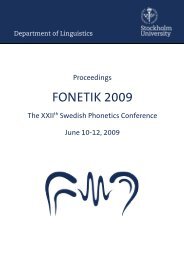The Double Passive in Swedish - Institutionen för lingvistik ...
The Double Passive in Swedish - Institutionen för lingvistik ...
The Double Passive in Swedish - Institutionen för lingvistik ...
You also want an ePaper? Increase the reach of your titles
YUMPU automatically turns print PDFs into web optimized ePapers that Google loves.
(9) a) Active:<br />
John servera-r Jane.<br />
3SG serve-PRS 3SG<br />
SUBJ OBJ<br />
‘John is serv<strong>in</strong>g Jane.’<br />
b) <strong>Passive</strong>:<br />
Jane servera-s av John.<br />
3SG serve-PASS by 3SG<br />
SUBJ OBLag<br />
‘Jane is be<strong>in</strong>g served by John’.<br />
Passivization is often referred to as an agent demot<strong>in</strong>g process <strong>in</strong> the literature (Laanemets, 2012).<br />
2.3 Lexical functional grammar<br />
In the thesis Lexical functional grammar (LFG) is used as a model for semantic and syntactic analysis.<br />
LFG is a theory where the explicit representation of morphosyntactic <strong>in</strong>formation is displayed by<br />
syntactic structures – the lexicon, words and unification is essential <strong>in</strong> the grammar (cf. Van Val<strong>in</strong>,<br />
2001; Kroeger, 2008; Bresnan, 2001). A special feature of LFG is that it analyses clauses <strong>in</strong> terms of<br />
at least three 5 dist<strong>in</strong>ct parallel levels of representation (Aust<strong>in</strong>, 2001:6-16):<br />
C-structure – <strong>The</strong> constituent structure analyses the constituents <strong>in</strong> terms of word order, and phrasal<br />
group<strong>in</strong>g <strong>in</strong> the form of context-free phrase structure trees.<br />
F-structure – <strong>The</strong> functional structure deal with functional <strong>in</strong>formation/features such as grammatical<br />
functions like SUBJ, OBJ and also with functions of discourse like TOPIC. <strong>The</strong> <strong>in</strong>formation is<br />
displayed <strong>in</strong> matrices of attribute-value pairs.<br />
A-structure – <strong>The</strong> argument structure deals with predicate argument <strong>in</strong>formation. E.g. number and<br />
type of arguments of an argument and the semantic role assigned by arguments, cf. (12). A-structures<br />
are displayed as arrays and predicates and argument slots with associated semantic roles such as<br />
AGENT, PATIENT and EXPERIENCER 6 .<br />
Below the relations between the f- and c-structures are shown accord<strong>in</strong>g to an example of an English<br />
passive clause taken from Van Val<strong>in</strong> (2001:191) <strong>in</strong> (Figure 1).<br />
5 <strong>The</strong>re are several other structures which are hypothesized <strong>in</strong> LFG work. However, solely the structures<br />
displayed <strong>in</strong> (2.3) are used <strong>in</strong> the thesis (cf. Falk, 2001).<br />
6<br />
<strong>The</strong> semantic roles are taken from Kroeger (2008:9) and Lyngfelt (2007). Lyngfelt prefers to devide the agent<br />
role <strong>in</strong>to agentive/cause which is partly applied <strong>in</strong> this thesis).<br />
EXPERIENCER; animate entity, which perceives a stimulus or registers a particular mental or emotional process<br />
or state. INSTRUMENT; <strong>in</strong>animate entity which undergoes a change of location or possession, or whose location<br />
is be<strong>in</strong>g specified. PATIENT; entity which is acted upon, affected, or created – or of which a state or change is<br />
predicated.<br />
12

















